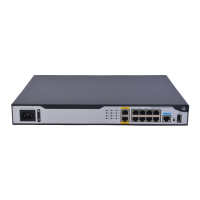320
Field Descri
tion
TID Kernel thread number.
No thread is excluded from
monitoring
All kernel threads are monitored by kernel thread deadloop detection.
display kernel exception
Use display kernel exception to display kernel thread exception information.
Syntax
Centralized devices in standalone mode:
display kernel exception show-number [ offset ] [ verbose ]
Distributed devices in standalone mode/centralized devices in IRF mode:
display kernel exception show-number [ offset ] [ verbose ] [ slot slot-number [ cpu cpu-number ] ]
Distributed devices in IRF mode:
display kernel exception show-number [ offset ] [ verbose ] [ chassis chassis-number slot slot-number [ cpu
cpu-number ] ]
Views
Any view
Predefined user roles
network-admin
Parameters
show-number: Specifies the number of kernel exceptions to display, in the range of 1 to 20.
offset: Specifies the offset between the starting exception and the latest exception, in the range of 0 to 19.
The default value is 0.
verbose: Displays detailed information. If you do not specify this keyword, the command displays brief
information.
slot slot-number: Specifies an MPU by its slot number. If you do not specify this option, the command
displays kernel thread exception information for the active MPU. (Distributed devices in standalone
mode.)
slot slot-number: Specifies an IRF member device by its ID. If you do not specify this option, the command
displays kernel thread exception information for the master device. (Centralized devices in IRF mode.)
chassis chassis-number slot slot-number: Specifies an MPU on an IRF member device. If you do not
specify this option, the command displays kernel thread exception information for the global active MPU.
(Distributed devices in IRF mode.)
cpu cpu-number: Specifies a CPU by its number.
Usage guidelines
If an exception occurs to a running kernel thread, the system automatically records the exception
information.

